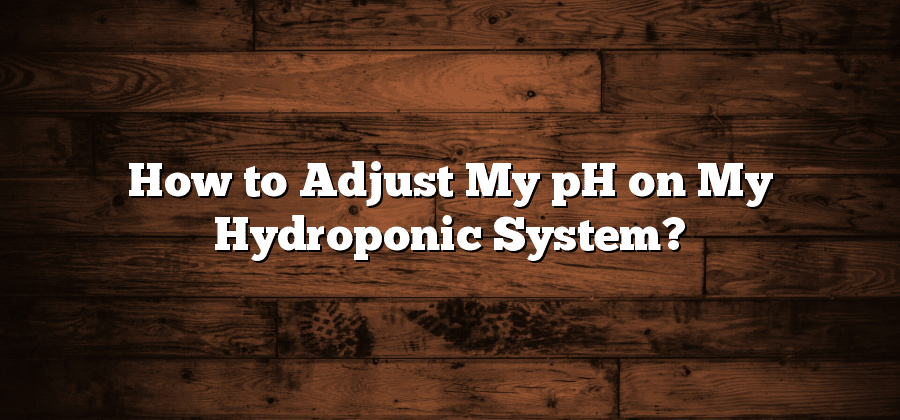Understanding pH Levels in Hydroponic Systems
pH levels play a crucial role in the success of hydroponic gardening. Understanding and maintaining the appropriate pH balance is essential for optimal plant growth and nutrient uptake in hydroponic systems. pH is a measure of the acidity or alkalinity of a solution, and in hydroponics, it refers to the acidity or alkalinity of the nutrient solution provided to the plants.
Maintaining the correct pH range in hydroponic systems is vital because it directly affects the availability of essential nutrients to the plants. The majority of plants prefer a slightly acidic pH range between 5.5 and 6.5. When the pH deviates from this optimal range, nutrient deficiencies or toxicities may occur, hindering plant growth and overall productivity. Therefore, monitoring and adjusting pH levels in hydroponic systems is a critical aspect of successful hydroponic gardening.
Importance of pH Balance for Successful Hydroponic Gardening
Maintaining a proper pH balance is crucial for achieving success in hydroponic gardening. pH, which stands for “potential of hydrogen,” is a measure of the acidity or alkalinity of a solution. In hydroponics, the pH level directly affects the availability of nutrients to the plants. The ideal pH range for hydroponic systems is typically between 5.5 and 6.5, slightly acidic to neutral.
When the pH level is too high or too low, it can cause nutrient lockout, meaning that the plants are unable to absorb and utilize the necessary nutrients for growth. This can result in stunted or unhealthy plants, hindered root development, and reduced overall yield. Therefore, maintaining a balanced pH is essential for providing the optimal environment for plants to thrive in a hydroponic system.
Testing pH: Choosing the Right Method for Accurate Results
Testing the pH levels of your hydroponic system is crucial for maintaining the ideal balance for your plants to thrive. There are several methods available for testing pH, and choosing the right one is essential to ensure accurate results.
One common method is using pH test strips. These thin strips are coated with a special indicator that changes color based on the pH level of the solution being tested. To use them, simply dip a strip into the nutrient solution or water sample and compare the color change to a chart provided with the test strips. This method is relatively inexpensive and easy to use, making it a popular choice among hydroponic gardeners. However, keep in mind that pH test strips may not be as precise as other methods, so it is important to use them as a general guide rather than rely solely on their results.
Interpreting pH Test Results: What the Numbers Mean
When it comes to interpreting pH test results in hydroponic systems, it is essential to understand what the numbers mean. The pH scale ranges from 0 to 14, with 7 being considered neutral. For most hydroponic plants, the ideal pH range is slightly acidic, between 5.5 and 6.5.
If the pH of your hydroponic solution is below 5.5, this indicates that it is too acidic. This can lead to nutrient lockout, where the plants are unable to absorb essential nutrients properly. On the other hand, if the pH is above 6.5, it means that the solution is too alkaline. This can also result in nutrient deficiencies as certain elements become less available to the plants at higher pH levels.
Regular monitoring and interpretation of pH test results will allow you to make necessary adjustments to maintain the optimal pH range for your hydroponic system. It is important to keep in mind that different plants may have slightly different pH preferences, so it is crucial to research the specific requirements of the plants you are growing to achieve optimal results.
Common Causes of pH Imbalance in Hydroponic Systems
Common Causes of pH Imbalance in Hydroponic Systems
One of the leading causes of pH imbalance in hydroponic systems is the use of tap water. While tap water is readily available and convenient to use, it often contains impurities and mineral residues that can disrupt the pH levels in the system. These impurities include calcium, magnesium, and other minerals that can raise the pH levels and make it more alkaline. It is essential to monitor the quality of the water used in the system and consider using purified or filtered water to avoid pH imbalances.
Another common cause of pH imbalance is the accumulation of excess nutrients in the system. In hydroponic gardening, nutrients are supplied directly to the plants through the water solution. However, if the nutrient solution is not properly balanced or if excessive amounts of nutrients are added, it can lead to an imbalance in pH levels. High levels of nutrients can lower the pH, making the solution more acidic, while low nutrient levels can cause the pH to become more alkaline. To maintain a proper pH balance, it is crucial to carefully measure and adjust the nutrient levels in the solution to meet the specific needs of the plants being grown.






